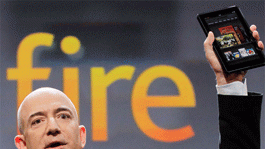Kindle Fire launches with sales of one million units per week

The Kindle Fire is a unique content-consumption device, not quite a full tablet and certainly not a smartphone, but sharing traits of both. And not unlike tablets and mobile phones, the Kindle Fire appears to have had a stellar launch.
Amazon is reporting that in Dec. 2011, the Kindle Fire was selling one million units per week, providing more than 4 million shipped for a robust holiday season. The company ships a free trial of Amazon Prime with each device, and it is with that service that the mobile-TV aspect of the unit really kicks in. Offering thousands of shows and movies, and featuring a nice widescreen portable device to watch them on, the Kindle Fire could do more to move the needle of mobile TV than smartphones have in recent memory.
With a 7in. color touchscreen and 16 million high-resolution colors, the screen uses in-plane switching (IPS) technology for a wider viewing angle. This means that customers can sit together and watch their content and all get a good angle of view, something that is harder on smaller smartphones. In addition to the Amazon Prime all-you-can-watch stable of 10,000 movies and TV shows, the unit also allows rental and purchase of 100,000 more TV shows and movies for on-the-go mobile entertainment.
Although the sales numbers are great, and no one really expected them to be meek, the Kindle Fire has come under fire for various reasons during a bumpy launch span. Technology-wise there were many reports of sluggish performance and overall speed issues. It just was not that fast to jump around with and even something that should not be taxing, such as turning pages in an e-book, was slightly sluggish. Amazon responded to the mixed reviews by promising performance updates to speed up navigation, and indeed, the company has already delivered software updates that help things run smoother.
Also, the “ultra-fast” Web browser the unit ships with, Amazon Silk, which supposedly tracks customers’ surfing and caches pages it thinks they may visit, has turned out to be just about as fast as any other browser. Amazon does say that performance will improve over time, so we shall see. Additionally, the unit was deemed heavier than it should have been, although most loved being able to access all their Kindle content on demand.
iPad comparisons were inevitable, and it really came down to iPad owners vs. first-time tablet purchasers. If people owned an iPad, there was no comparison, nor should there be with a lower-end budget-priced alternative. The Kindle Fire was nowhere near the performance and stability of the iPad. However, those who had never used or owned a tablet in their life were generally happy, mainly because, not unlike the iPad, the new unit did so much to entertain a new audience.
Rumor has it that Amazon will launch a 10in. version in the first quarter of 2012, which will be another interesting wrinkle to their Kindle product line. But, as a mobile device for watching video content, surfing the Web and exploring e-books, the Kindle Fire does seem off to a promising start.
The professional video industry's #1 source for news, trends and product and tech information. Sign up below.
